Balance in the Dark … It Can Be a Challenge
The theme for this week …
Recently I wrote about balance being more than standing on one leg. Continuing with the theme of balance, nighttime brings unique challenges due to limitations of our visual sensory feedback. Read on …
Balance at night
A lesser known aspect of physical balance is related to the impact of our surroundings, in particular, illumination levels.
Balance skills in the night time can be even more challenging. Clinical research recognizes this and has specific physical balance tests for eyes closed, which simulates balance reactions in a dark environment.
Why is balance in the dark harder?
From a neurological perspective, balance reactions result from the brain processing three separate information streams. The sensory information comes from the:
- Vestibular system
- Proprioceptive system (muscle/tendon/ligament neurons signaling where our body is in space)
- Visual system
During the day, or in well-lit surroundings, our brain can use the visual input from this multi-sensory feedback involved in directing postural balance reactions.
In the dark, the visual component is reduced or absent. If your brain has diminished input from the other two sensory systems, your balance reactions will be compromised.
How can Bridging® help? What else can I do?
We often find that prior injuries muck up the communication pathways of proprioceptive sensory feedback. The relevant locations which generate this type of feedback are primarily in the feet, ankles, hips, and the low back.
When Bridging® resets the muscle relationships of the lower body, proprioceptive sensory signals are more robust, and balance in the dark becomes much more controlled.
There are balance training activities and exercises you can practice in increasingly low light environments. Although they don’t address the root cause, they will help you to get more from the ability you have available.
Insight of the Week from Cara
Functional Balance in the dark
When people tell me their balance is bad, a question I ask is “When is your balance off?”
- Getting up in the morning?
- Going to the toilet in the night?
- Returning to your car in the evening?
Each of these provides a different clue for which part of the body may not be holding up its share of the balance work.
Balance training, or is there more?
When I met Sue, she was doing balance training, but still felt unsteady. Low light situations were when she felt most vulnerable.
The exercises she had were all being done in regular lighting conditions, so they were not fully addressing her issue. She was hoping there was a better solution.
Using the Bridging® assessment process here is what we found:
- Prior injury: Her lower leg was previously broken and cast.
- Rigidity: The finer ankle micromovements were rigid, as if the cast was still present.
- Missing transitions: The small muscles, tendons, and ligaments at her ankle were not fully translating movement in the foot up to the rest of the body. (This creates the proprioceptive sensory feedback.)
After reintroducing light oscillatory movement to her ankle, the rigidity melted away. Sue could walk more fluently, and even better, was able to balance confidently in the dark. Yay!
How to tell if you may have an issue with balance in low light?
I created a series of Functional Self-Assessment videos so you can get a sense of how you’re doing. There is an overview video, then the individual assessments. And, yes, Bridging® can help reset your balance reactions. See below for more details and a link.
Another Functional Balance Self-Assessment video
Self-Assessment #2 Eyes Closed Balance
This assessment provides insight you can use to tell how well your balance reactions work in low light conditions. The formal clinical test uses a soft pad underfoot; I’ve simplified the assessment for you to do it at home.
Limited visual feedback and balance control?
You should be able to stand steady for 30 seconds with your eyes closed with only slight postural movements. If you begin to sway more, open your eyes. (Do this near a wall and/or chair so you have a support to keep things safe.)
What do the results tell me?
If you are unsteady in this assessment, you need to pay special attention when you are moving in a dark environment. Ask for help, find something to hold onto, and improve your use of night lights at home.
The Functional Self-Assessment video series allows you to get a sense of how you’re doing related to discrete aspects of functional balance and strength. In each video there is an explanation of why the skill is relevant. There will be five FREE self-assessments in the YouTube video series.
Each assessment is based upon a clinical assessment sub-test which has formal directions, measurement, and interpretation. The usage shown is consistent with, but not as detailed as the clinical assessment. You can use the results for your own insight.
How to use the videos?
Do each test, and periodically repeat. Just like measuring your weight or BP, you will have a record of your normal. You will be able to objectively tell when a change happens.
Example:
If you recently tripped and fell, you look fine, but feel unsteady. Having a baseline for comparison is helpful, so you can understand if balance reactions were impacted.
If your results indicate an area of concern, what next?
Depending upon your overall healthcare situation, you may want to ask your physician for a Physical Therapy evaluation and exercises. When balance exercises are impractical or ineffective, Bridging® can provide insights on ‘why’ your balance reactions are off, and address the cause.

